Business and Business Environment Analysis Report - Module Name
VerifiedAdded on 2020/10/05
|7
|1876
|336
Report
AI Summary
This report provides a comprehensive analysis of Sainsbury's business environment, examining its organizational structure, functions, and the interplay of internal and external factors. The report begins with an introduction to the importance of business environment, followed by an overview of different organizational types, including private, public, and voluntary sectors, and their respective legal structures. It then delves into the size and scope of organizations, using NHS, Sainsbury's, and Oxfam as examples. The report also explores the interrelation between different organizational departments, such as marketing, human resources, and finance, and their link to overall business objectives. The analysis includes a discussion on the impact of internal and external factors on the firm and its relationship with the macro-environment. The report concludes by summarizing the key findings and emphasizing the importance of understanding the business environment for organizational success. References to relevant academic sources are also included.
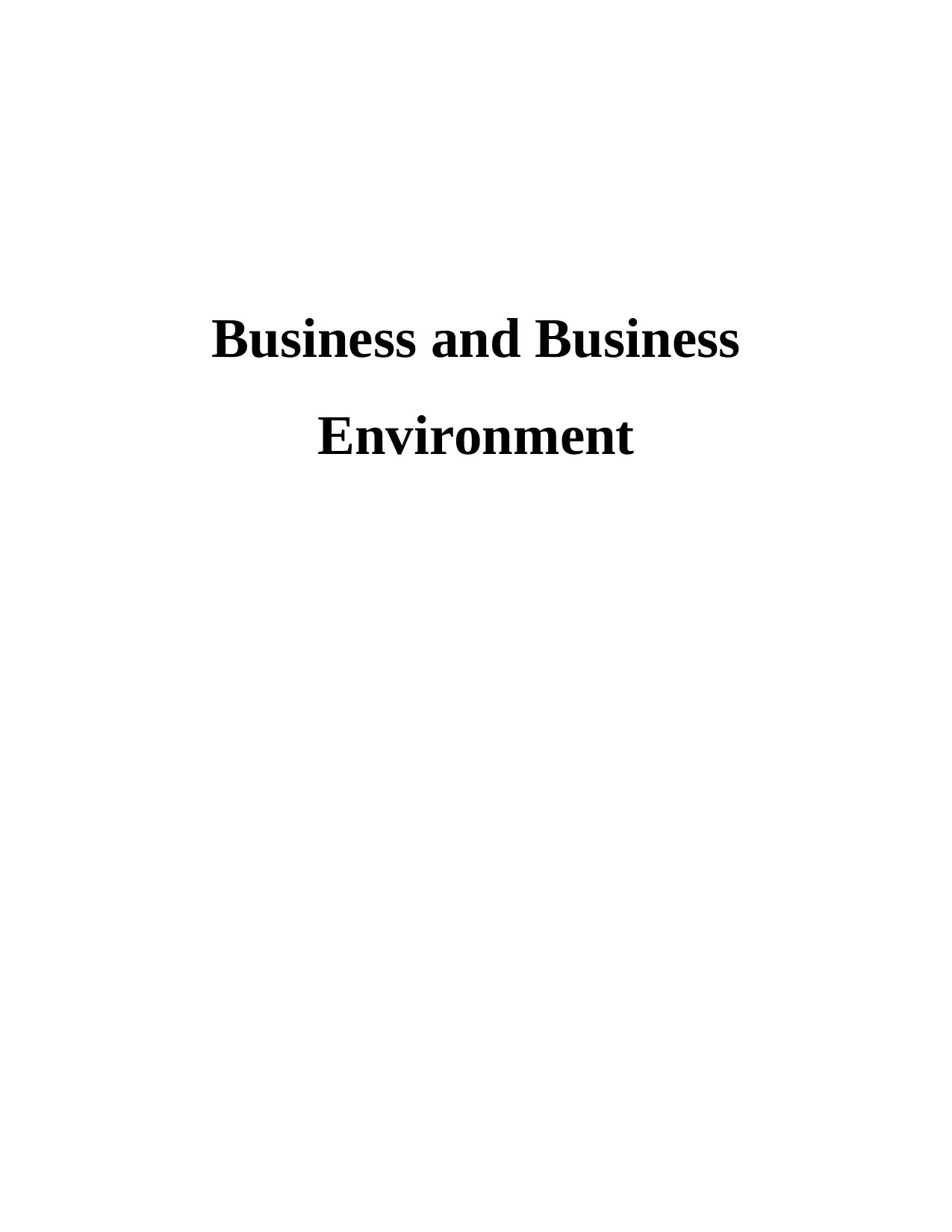
Business and Business
Environment
Environment
Paraphrase This Document
Need a fresh take? Get an instant paraphrase of this document with our AI Paraphraser
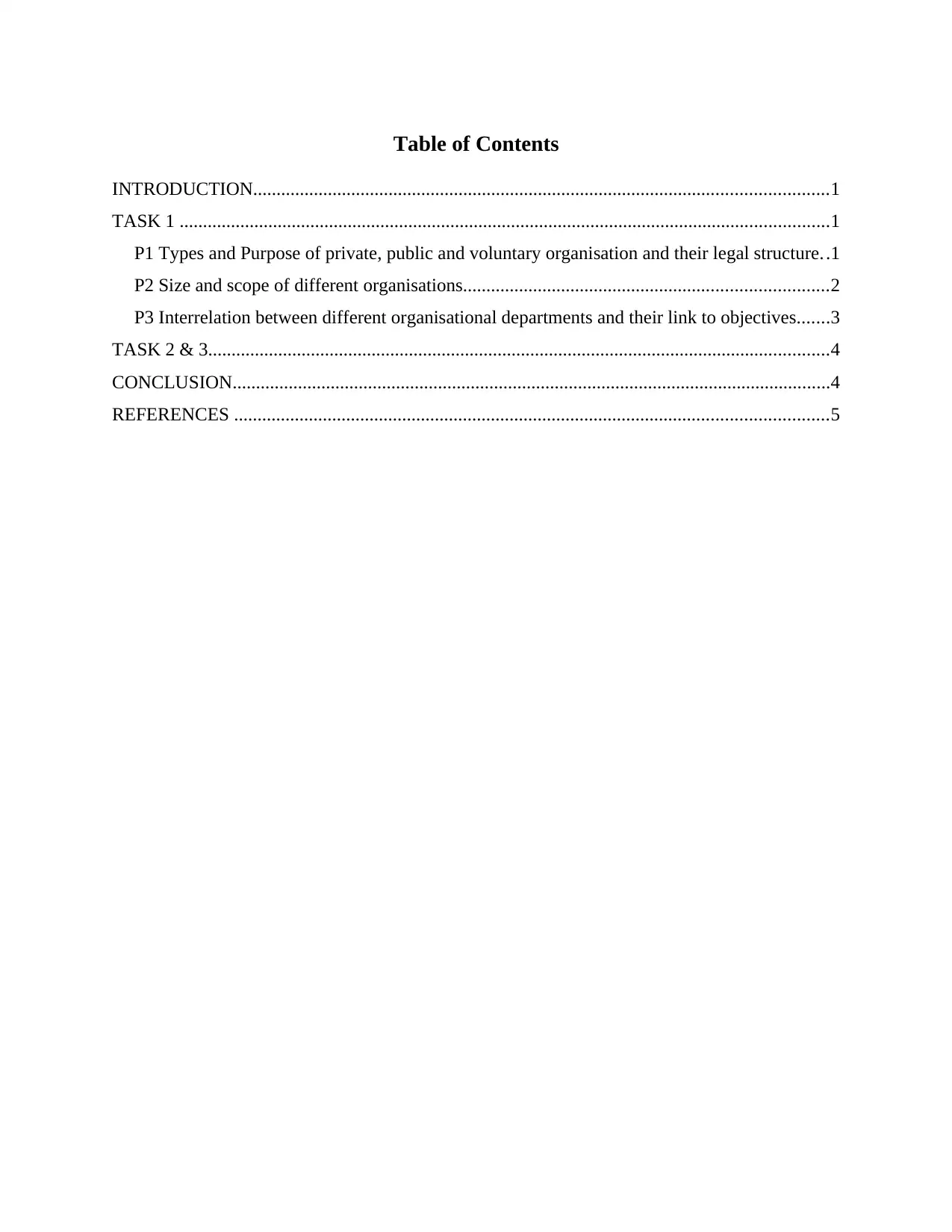
Table of Contents
INTRODUCTION...........................................................................................................................1
TASK 1 ...........................................................................................................................................1
P1 Types and Purpose of private, public and voluntary organisation and their legal structure. .1
P2 Size and scope of different organisations..............................................................................2
P3 Interrelation between different organisational departments and their link to objectives.......3
TASK 2 & 3.....................................................................................................................................4
CONCLUSION................................................................................................................................4
REFERENCES ...............................................................................................................................5
INTRODUCTION...........................................................................................................................1
TASK 1 ...........................................................................................................................................1
P1 Types and Purpose of private, public and voluntary organisation and their legal structure. .1
P2 Size and scope of different organisations..............................................................................2
P3 Interrelation between different organisational departments and their link to objectives.......3
TASK 2 & 3.....................................................................................................................................4
CONCLUSION................................................................................................................................4
REFERENCES ...............................................................................................................................5
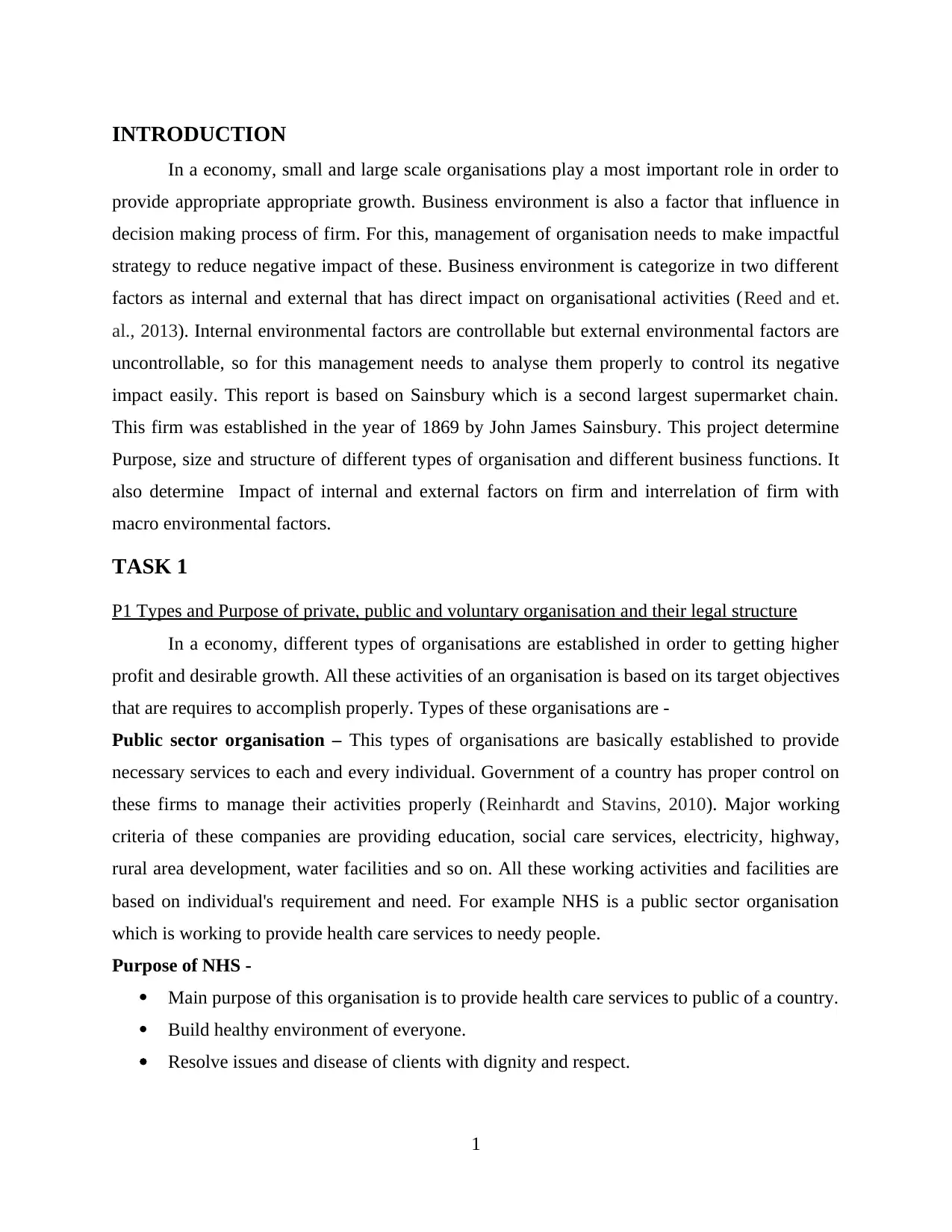
INTRODUCTION
In a economy, small and large scale organisations play a most important role in order to
provide appropriate appropriate growth. Business environment is also a factor that influence in
decision making process of firm. For this, management of organisation needs to make impactful
strategy to reduce negative impact of these. Business environment is categorize in two different
factors as internal and external that has direct impact on organisational activities (Reed and et.
al., 2013). Internal environmental factors are controllable but external environmental factors are
uncontrollable, so for this management needs to analyse them properly to control its negative
impact easily. This report is based on Sainsbury which is a second largest supermarket chain.
This firm was established in the year of 1869 by John James Sainsbury. This project determine
Purpose, size and structure of different types of organisation and different business functions. It
also determine Impact of internal and external factors on firm and interrelation of firm with
macro environmental factors.
TASK 1
P1 Types and Purpose of private, public and voluntary organisation and their legal structure
In a economy, different types of organisations are established in order to getting higher
profit and desirable growth. All these activities of an organisation is based on its target objectives
that are requires to accomplish properly. Types of these organisations are -
Public sector organisation – This types of organisations are basically established to provide
necessary services to each and every individual. Government of a country has proper control on
these firms to manage their activities properly (Reinhardt and Stavins, 2010). Major working
criteria of these companies are providing education, social care services, electricity, highway,
rural area development, water facilities and so on. All these working activities and facilities are
based on individual's requirement and need. For example NHS is a public sector organisation
which is working to provide health care services to needy people.
Purpose of NHS -
Main purpose of this organisation is to provide health care services to public of a country.
Build healthy environment of everyone.
Resolve issues and disease of clients with dignity and respect.
1
In a economy, small and large scale organisations play a most important role in order to
provide appropriate appropriate growth. Business environment is also a factor that influence in
decision making process of firm. For this, management of organisation needs to make impactful
strategy to reduce negative impact of these. Business environment is categorize in two different
factors as internal and external that has direct impact on organisational activities (Reed and et.
al., 2013). Internal environmental factors are controllable but external environmental factors are
uncontrollable, so for this management needs to analyse them properly to control its negative
impact easily. This report is based on Sainsbury which is a second largest supermarket chain.
This firm was established in the year of 1869 by John James Sainsbury. This project determine
Purpose, size and structure of different types of organisation and different business functions. It
also determine Impact of internal and external factors on firm and interrelation of firm with
macro environmental factors.
TASK 1
P1 Types and Purpose of private, public and voluntary organisation and their legal structure
In a economy, different types of organisations are established in order to getting higher
profit and desirable growth. All these activities of an organisation is based on its target objectives
that are requires to accomplish properly. Types of these organisations are -
Public sector organisation – This types of organisations are basically established to provide
necessary services to each and every individual. Government of a country has proper control on
these firms to manage their activities properly (Reinhardt and Stavins, 2010). Major working
criteria of these companies are providing education, social care services, electricity, highway,
rural area development, water facilities and so on. All these working activities and facilities are
based on individual's requirement and need. For example NHS is a public sector organisation
which is working to provide health care services to needy people.
Purpose of NHS -
Main purpose of this organisation is to provide health care services to public of a country.
Build healthy environment of everyone.
Resolve issues and disease of clients with dignity and respect.
1
⊘ This is a preview!⊘
Do you want full access?
Subscribe today to unlock all pages.

Trusted by 1+ million students worldwide
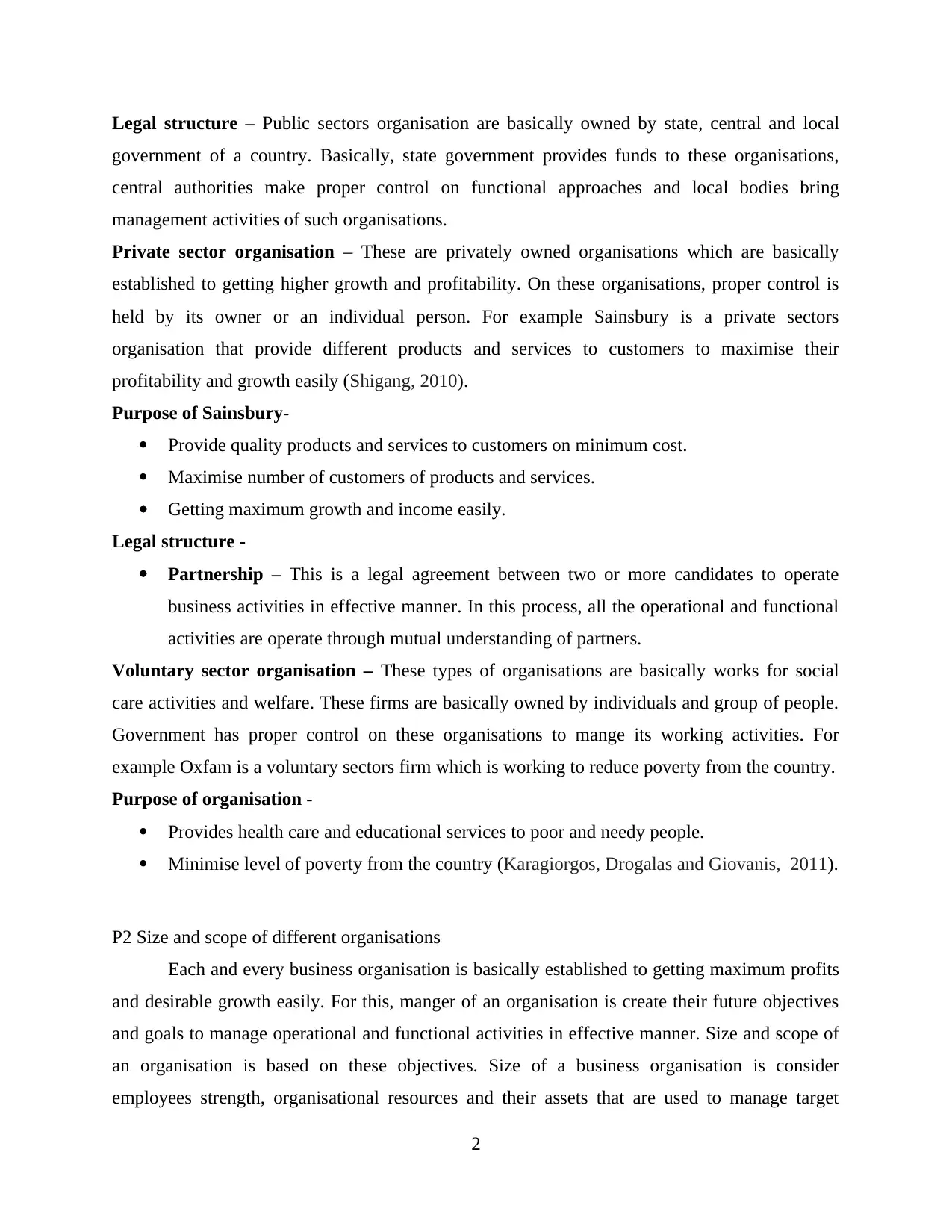
Legal structure – Public sectors organisation are basically owned by state, central and local
government of a country. Basically, state government provides funds to these organisations,
central authorities make proper control on functional approaches and local bodies bring
management activities of such organisations.
Private sector organisation – These are privately owned organisations which are basically
established to getting higher growth and profitability. On these organisations, proper control is
held by its owner or an individual person. For example Sainsbury is a private sectors
organisation that provide different products and services to customers to maximise their
profitability and growth easily (Shigang, 2010).
Purpose of Sainsbury-
Provide quality products and services to customers on minimum cost.
Maximise number of customers of products and services.
Getting maximum growth and income easily.
Legal structure -
Partnership – This is a legal agreement between two or more candidates to operate
business activities in effective manner. In this process, all the operational and functional
activities are operate through mutual understanding of partners.
Voluntary sector organisation – These types of organisations are basically works for social
care activities and welfare. These firms are basically owned by individuals and group of people.
Government has proper control on these organisations to mange its working activities. For
example Oxfam is a voluntary sectors firm which is working to reduce poverty from the country.
Purpose of organisation -
Provides health care and educational services to poor and needy people.
Minimise level of poverty from the country (Karagiorgos, Drogalas and Giovanis, 2011).
P2 Size and scope of different organisations
Each and every business organisation is basically established to getting maximum profits
and desirable growth easily. For this, manger of an organisation is create their future objectives
and goals to manage operational and functional activities in effective manner. Size and scope of
an organisation is based on these objectives. Size of a business organisation is consider
employees strength, organisational resources and their assets that are used to manage target
2
government of a country. Basically, state government provides funds to these organisations,
central authorities make proper control on functional approaches and local bodies bring
management activities of such organisations.
Private sector organisation – These are privately owned organisations which are basically
established to getting higher growth and profitability. On these organisations, proper control is
held by its owner or an individual person. For example Sainsbury is a private sectors
organisation that provide different products and services to customers to maximise their
profitability and growth easily (Shigang, 2010).
Purpose of Sainsbury-
Provide quality products and services to customers on minimum cost.
Maximise number of customers of products and services.
Getting maximum growth and income easily.
Legal structure -
Partnership – This is a legal agreement between two or more candidates to operate
business activities in effective manner. In this process, all the operational and functional
activities are operate through mutual understanding of partners.
Voluntary sector organisation – These types of organisations are basically works for social
care activities and welfare. These firms are basically owned by individuals and group of people.
Government has proper control on these organisations to mange its working activities. For
example Oxfam is a voluntary sectors firm which is working to reduce poverty from the country.
Purpose of organisation -
Provides health care and educational services to poor and needy people.
Minimise level of poverty from the country (Karagiorgos, Drogalas and Giovanis, 2011).
P2 Size and scope of different organisations
Each and every business organisation is basically established to getting maximum profits
and desirable growth easily. For this, manger of an organisation is create their future objectives
and goals to manage operational and functional activities in effective manner. Size and scope of
an organisation is based on these objectives. Size of a business organisation is consider
employees strength, organisational resources and their assets that are used to manage target
2
Paraphrase This Document
Need a fresh take? Get an instant paraphrase of this document with our AI Paraphraser
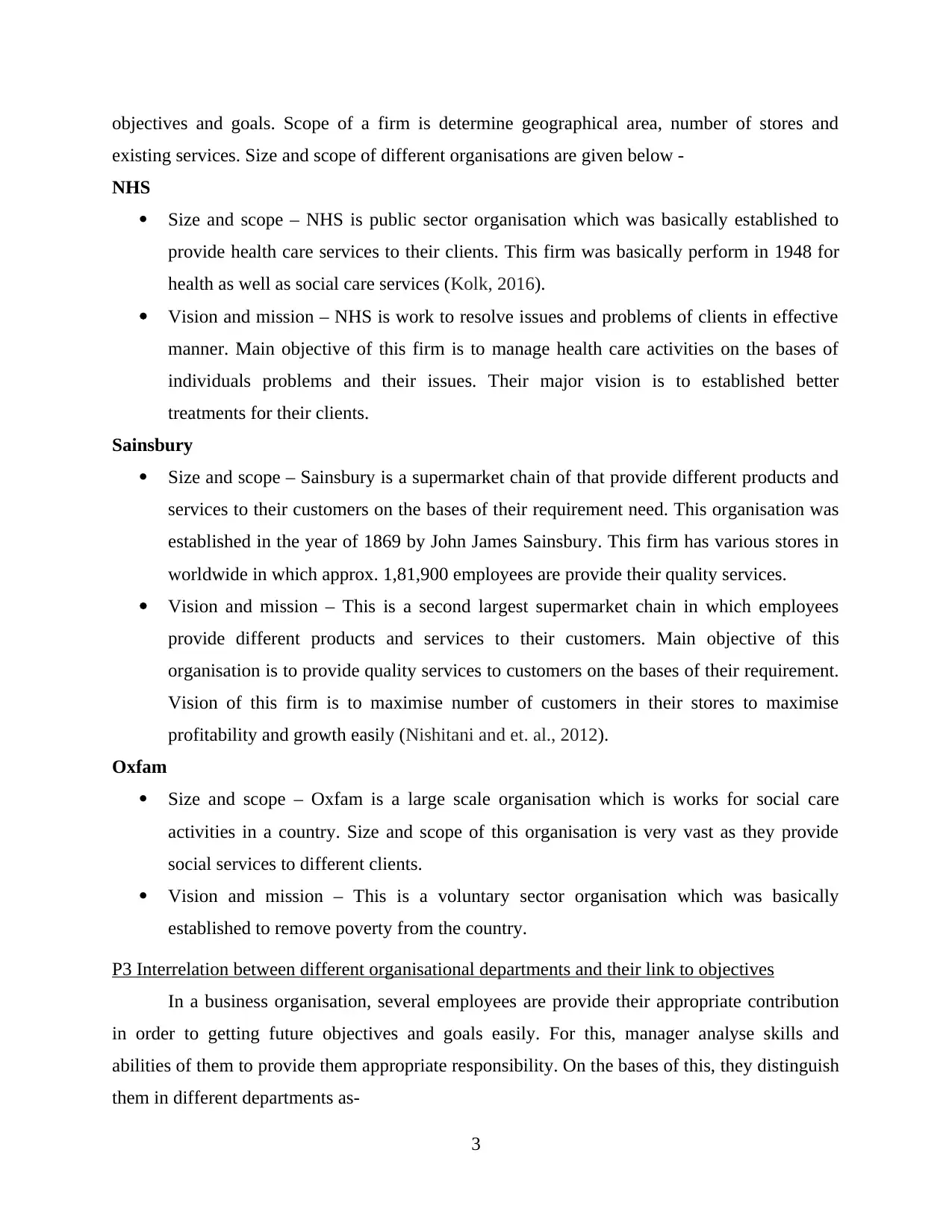
objectives and goals. Scope of a firm is determine geographical area, number of stores and
existing services. Size and scope of different organisations are given below -
NHS
Size and scope – NHS is public sector organisation which was basically established to
provide health care services to their clients. This firm was basically perform in 1948 for
health as well as social care services (Kolk, 2016).
Vision and mission – NHS is work to resolve issues and problems of clients in effective
manner. Main objective of this firm is to manage health care activities on the bases of
individuals problems and their issues. Their major vision is to established better
treatments for their clients.
Sainsbury
Size and scope – Sainsbury is a supermarket chain of that provide different products and
services to their customers on the bases of their requirement need. This organisation was
established in the year of 1869 by John James Sainsbury. This firm has various stores in
worldwide in which approx. 1,81,900 employees are provide their quality services.
Vision and mission – This is a second largest supermarket chain in which employees
provide different products and services to their customers. Main objective of this
organisation is to provide quality services to customers on the bases of their requirement.
Vision of this firm is to maximise number of customers in their stores to maximise
profitability and growth easily (Nishitani and et. al., 2012).
Oxfam
Size and scope – Oxfam is a large scale organisation which is works for social care
activities in a country. Size and scope of this organisation is very vast as they provide
social services to different clients.
Vision and mission – This is a voluntary sector organisation which was basically
established to remove poverty from the country.
P3 Interrelation between different organisational departments and their link to objectives
In a business organisation, several employees are provide their appropriate contribution
in order to getting future objectives and goals easily. For this, manager analyse skills and
abilities of them to provide them appropriate responsibility. On the bases of this, they distinguish
them in different departments as-
3
existing services. Size and scope of different organisations are given below -
NHS
Size and scope – NHS is public sector organisation which was basically established to
provide health care services to their clients. This firm was basically perform in 1948 for
health as well as social care services (Kolk, 2016).
Vision and mission – NHS is work to resolve issues and problems of clients in effective
manner. Main objective of this firm is to manage health care activities on the bases of
individuals problems and their issues. Their major vision is to established better
treatments for their clients.
Sainsbury
Size and scope – Sainsbury is a supermarket chain of that provide different products and
services to their customers on the bases of their requirement need. This organisation was
established in the year of 1869 by John James Sainsbury. This firm has various stores in
worldwide in which approx. 1,81,900 employees are provide their quality services.
Vision and mission – This is a second largest supermarket chain in which employees
provide different products and services to their customers. Main objective of this
organisation is to provide quality services to customers on the bases of their requirement.
Vision of this firm is to maximise number of customers in their stores to maximise
profitability and growth easily (Nishitani and et. al., 2012).
Oxfam
Size and scope – Oxfam is a large scale organisation which is works for social care
activities in a country. Size and scope of this organisation is very vast as they provide
social services to different clients.
Vision and mission – This is a voluntary sector organisation which was basically
established to remove poverty from the country.
P3 Interrelation between different organisational departments and their link to objectives
In a business organisation, several employees are provide their appropriate contribution
in order to getting future objectives and goals easily. For this, manager analyse skills and
abilities of them to provide them appropriate responsibility. On the bases of this, they distinguish
them in different departments as-
3
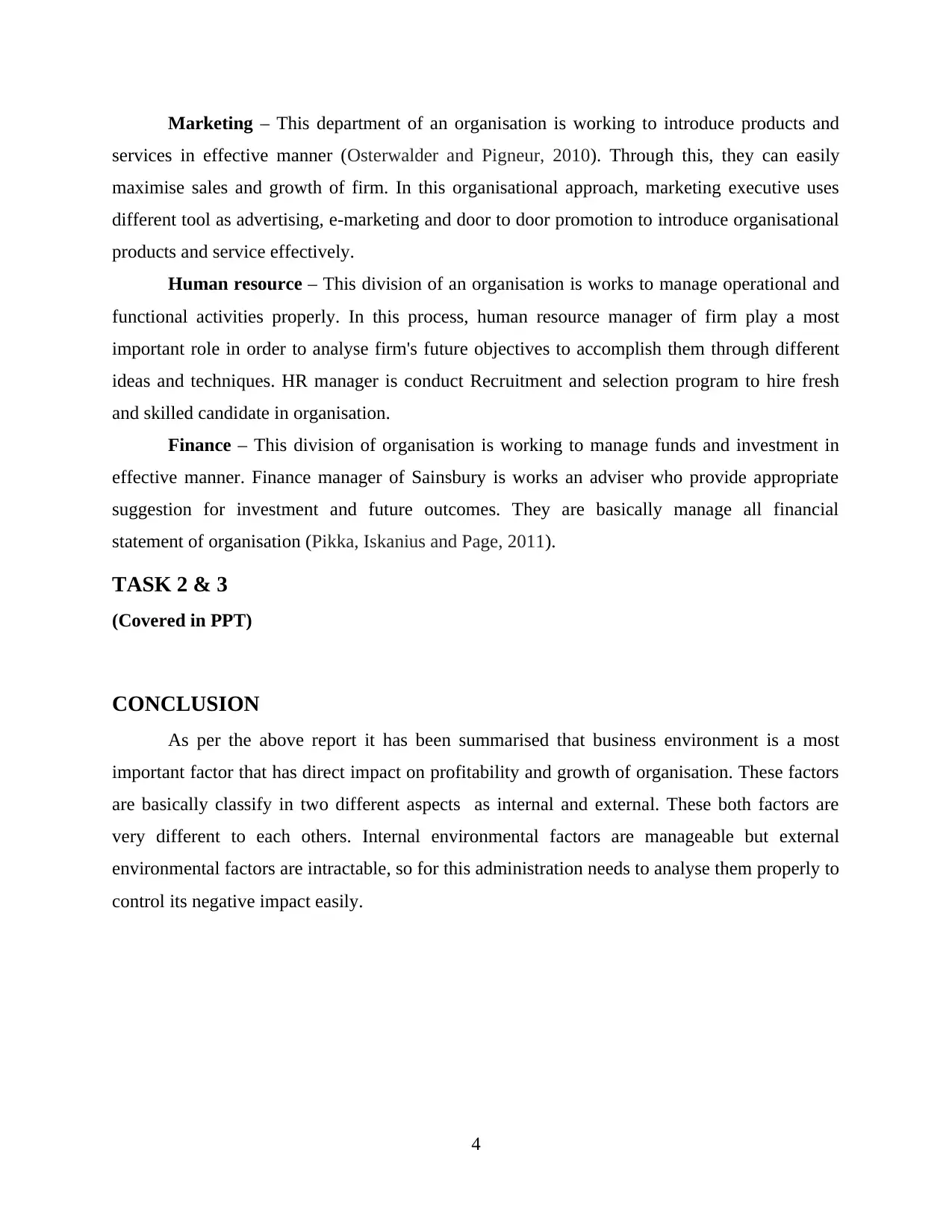
Marketing – This department of an organisation is working to introduce products and
services in effective manner (Osterwalder and Pigneur, 2010). Through this, they can easily
maximise sales and growth of firm. In this organisational approach, marketing executive uses
different tool as advertising, e-marketing and door to door promotion to introduce organisational
products and service effectively.
Human resource – This division of an organisation is works to manage operational and
functional activities properly. In this process, human resource manager of firm play a most
important role in order to analyse firm's future objectives to accomplish them through different
ideas and techniques. HR manager is conduct Recruitment and selection program to hire fresh
and skilled candidate in organisation.
Finance – This division of organisation is working to manage funds and investment in
effective manner. Finance manager of Sainsbury is works an adviser who provide appropriate
suggestion for investment and future outcomes. They are basically manage all financial
statement of organisation (Pikka, Iskanius and Page, 2011).
TASK 2 & 3
(Covered in PPT)
CONCLUSION
As per the above report it has been summarised that business environment is a most
important factor that has direct impact on profitability and growth of organisation. These factors
are basically classify in two different aspects as internal and external. These both factors are
very different to each others. Internal environmental factors are manageable but external
environmental factors are intractable, so for this administration needs to analyse them properly to
control its negative impact easily.
4
services in effective manner (Osterwalder and Pigneur, 2010). Through this, they can easily
maximise sales and growth of firm. In this organisational approach, marketing executive uses
different tool as advertising, e-marketing and door to door promotion to introduce organisational
products and service effectively.
Human resource – This division of an organisation is works to manage operational and
functional activities properly. In this process, human resource manager of firm play a most
important role in order to analyse firm's future objectives to accomplish them through different
ideas and techniques. HR manager is conduct Recruitment and selection program to hire fresh
and skilled candidate in organisation.
Finance – This division of organisation is working to manage funds and investment in
effective manner. Finance manager of Sainsbury is works an adviser who provide appropriate
suggestion for investment and future outcomes. They are basically manage all financial
statement of organisation (Pikka, Iskanius and Page, 2011).
TASK 2 & 3
(Covered in PPT)
CONCLUSION
As per the above report it has been summarised that business environment is a most
important factor that has direct impact on profitability and growth of organisation. These factors
are basically classify in two different aspects as internal and external. These both factors are
very different to each others. Internal environmental factors are manageable but external
environmental factors are intractable, so for this administration needs to analyse them properly to
control its negative impact easily.
4
⊘ This is a preview!⊘
Do you want full access?
Subscribe today to unlock all pages.

Trusted by 1+ million students worldwide
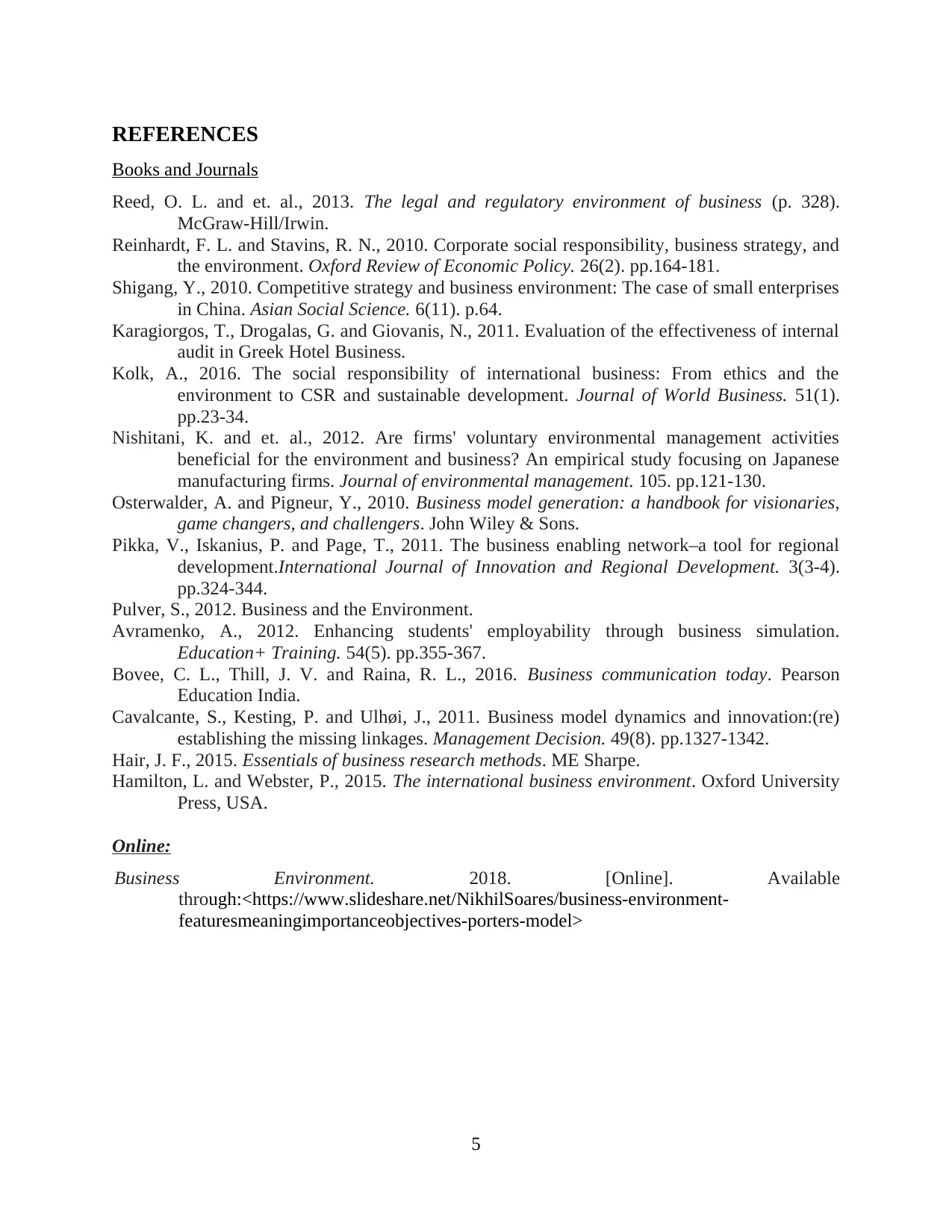
REFERENCES
Books and Journals
Reed, O. L. and et. al., 2013. The legal and regulatory environment of business (p. 328).
McGraw-Hill/Irwin.
Reinhardt, F. L. and Stavins, R. N., 2010. Corporate social responsibility, business strategy, and
the environment. Oxford Review of Economic Policy. 26(2). pp.164-181.
Shigang, Y., 2010. Competitive strategy and business environment: The case of small enterprises
in China. Asian Social Science. 6(11). p.64.
Karagiorgos, T., Drogalas, G. and Giovanis, N., 2011. Evaluation of the effectiveness of internal
audit in Greek Hotel Business.
Kolk, A., 2016. The social responsibility of international business: From ethics and the
environment to CSR and sustainable development. Journal of World Business. 51(1).
pp.23-34.
Nishitani, K. and et. al., 2012. Are firms' voluntary environmental management activities
beneficial for the environment and business? An empirical study focusing on Japanese
manufacturing firms. Journal of environmental management. 105. pp.121-130.
Osterwalder, A. and Pigneur, Y., 2010. Business model generation: a handbook for visionaries,
game changers, and challengers. John Wiley & Sons.
Pikka, V., Iskanius, P. and Page, T., 2011. The business enabling network–a tool for regional
development.International Journal of Innovation and Regional Development. 3(3-4).
pp.324-344.
Pulver, S., 2012. Business and the Environment.
Avramenko, A., 2012. Enhancing students' employability through business simulation.
Education+ Training. 54(5). pp.355-367.
Bovee, C. L., Thill, J. V. and Raina, R. L., 2016. Business communication today. Pearson
Education India.
Cavalcante, S., Kesting, P. and Ulhøi, J., 2011. Business model dynamics and innovation:(re)
establishing the missing linkages. Management Decision. 49(8). pp.1327-1342.
Hair, J. F., 2015. Essentials of business research methods. ME Sharpe.
Hamilton, L. and Webster, P., 2015. The international business environment. Oxford University
Press, USA.
Online:
Business Environment. 2018. [Online]. Available
through:<https://www.slideshare.net/NikhilSoares/business-environment-
featuresmeaningimportanceobjectives-porters-model>
5
Books and Journals
Reed, O. L. and et. al., 2013. The legal and regulatory environment of business (p. 328).
McGraw-Hill/Irwin.
Reinhardt, F. L. and Stavins, R. N., 2010. Corporate social responsibility, business strategy, and
the environment. Oxford Review of Economic Policy. 26(2). pp.164-181.
Shigang, Y., 2010. Competitive strategy and business environment: The case of small enterprises
in China. Asian Social Science. 6(11). p.64.
Karagiorgos, T., Drogalas, G. and Giovanis, N., 2011. Evaluation of the effectiveness of internal
audit in Greek Hotel Business.
Kolk, A., 2016. The social responsibility of international business: From ethics and the
environment to CSR and sustainable development. Journal of World Business. 51(1).
pp.23-34.
Nishitani, K. and et. al., 2012. Are firms' voluntary environmental management activities
beneficial for the environment and business? An empirical study focusing on Japanese
manufacturing firms. Journal of environmental management. 105. pp.121-130.
Osterwalder, A. and Pigneur, Y., 2010. Business model generation: a handbook for visionaries,
game changers, and challengers. John Wiley & Sons.
Pikka, V., Iskanius, P. and Page, T., 2011. The business enabling network–a tool for regional
development.International Journal of Innovation and Regional Development. 3(3-4).
pp.324-344.
Pulver, S., 2012. Business and the Environment.
Avramenko, A., 2012. Enhancing students' employability through business simulation.
Education+ Training. 54(5). pp.355-367.
Bovee, C. L., Thill, J. V. and Raina, R. L., 2016. Business communication today. Pearson
Education India.
Cavalcante, S., Kesting, P. and Ulhøi, J., 2011. Business model dynamics and innovation:(re)
establishing the missing linkages. Management Decision. 49(8). pp.1327-1342.
Hair, J. F., 2015. Essentials of business research methods. ME Sharpe.
Hamilton, L. and Webster, P., 2015. The international business environment. Oxford University
Press, USA.
Online:
Business Environment. 2018. [Online]. Available
through:<https://www.slideshare.net/NikhilSoares/business-environment-
featuresmeaningimportanceobjectives-porters-model>
5
1 out of 7
Related Documents
Your All-in-One AI-Powered Toolkit for Academic Success.
+13062052269
info@desklib.com
Available 24*7 on WhatsApp / Email
![[object Object]](/_next/static/media/star-bottom.7253800d.svg)
Unlock your academic potential
Copyright © 2020–2025 A2Z Services. All Rights Reserved. Developed and managed by ZUCOL.





